Prevent foot pain and agony from stealing your mobility and wellness. Knowing what causes common foot problems and how to deal with them will help you continue a healthy and productive life.
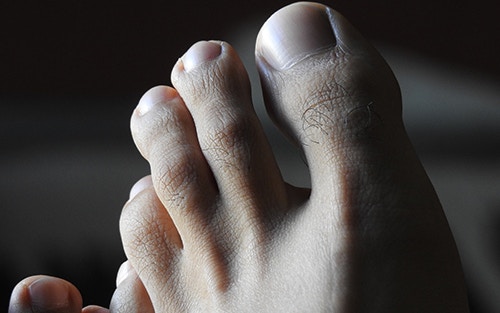
yourfootpalace.com gathered the following information about 7 significant and common foot problems, what causes them, how to treat them, and how to prevent them.
7 Common Foot Problems
The following 7 foot problems are common and easily treatable when addressed in their earliest stages.
Plantar Fasciitis
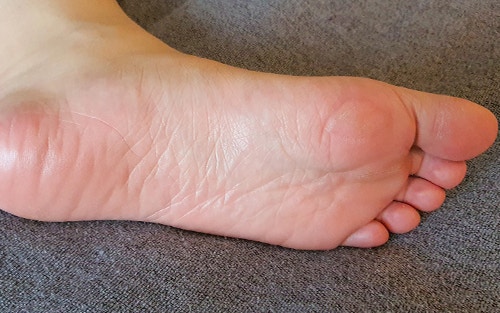
Plantar fasciitis is the inflammation of the plantar fascia (the tough tissue stretching from the heel bone to the base of the toes.
Causes – Plantar fasciitis is most commonly caused by repetitive strain injury to the plantar fascia. This strain injury can occur from excessive running or walking, inadequately fitted footgear, and jumping injury from strained landings.
Symptoms – Plantar fasciitis will typically cause stabbing pain in the bottom of your foot (usually near the heel). The pain is usually at its most acute with the first few steps after awakening; the condition can also be triggered by standing for long periods or getting up after sitting.
Treatment – Most plantar fasciitis treatment plans include resting, icing the painful area, and stretching. More severe cases may require medication, orthotics, and even surgery.
Recovery Time – 6 to 12 months (or more) with continuous care and treatment.
Prevention – Use exercises and stretches designed to prevent plantar fasciitis daily.
Read more on plantar fasciitis.
Neuropathy (Peripheral Neuropathy)
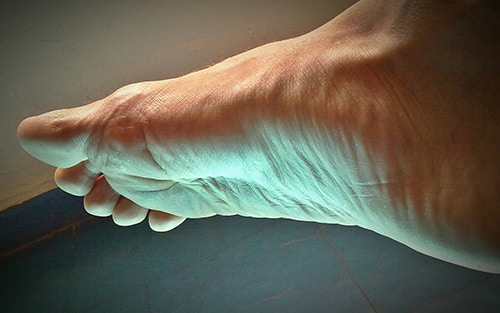
Peripheral neuropathy is often the result of damage to nerves outside of the brain and spinal cord (peripheral nerves)
Causes – Neuropathy can result from physical injury, infection, exposure to toxic substances, or conditions like diabetes, kidney failure, or malnutrition.
Symptoms – Peripheral neuropathy is a nerve problem that causes pain, numbness, tingling, swelling, or severe muscle weakness in different parts of the body (usually the extremities). This condition typically begins in the hands or feet and spreads, getting worse with time.
Treatment – Depending on the cause of your neuropathy, you may be prescribed a multi-faceted treatment approach, including:
- Physical Therapy
- Topical Treatments
- Pain Relievers
- Anti-seizure Medications
- Antidepressants
- Surgery
Neuropathy-related nerve pain may be relieved by medications like gabapentin (Gralise, Neurontin, Horizant) and pregabalin (Lyrica).
Note: In many cases, your doctor may recommend waiting to see if your neuropathy conditions improve before considering any treatments.
Recovery Time – If neuropathy symptoms diminish, the process will be gradual, requiring several months.
Prevention – While peripheral neuropathy may be caused by factors beyond your control, you can significantly reduce your risk for this condition by avoiding alcohol, correcting vitamin deficiencies, consuming a healthy diet, maintaining your weight and BMI below risk factors, avoiding toxins, and exercising regularly.
Learn more about peripheral neuropathy.
Metatarsalgia
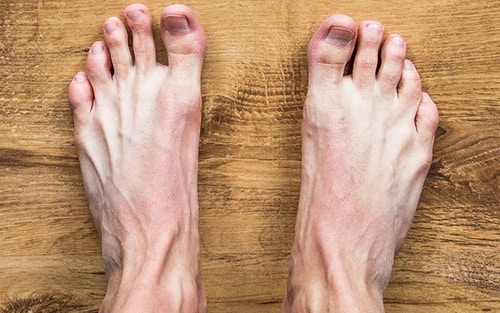
Metatarsalgia is a very common overuse condition affecting either or both feet in which the ball of your foot (the area between the arches and toes) becomes inflamed and painful.
Causes – Being a frequent runner, wearing poorly fitting shoes or high heels, and excess weight can lead to metatarsalgia. If you have rheumatoid arthritis, osteoarthritis, or gout, these conditions can exacerbate metatarsalgia.
Symptoms – Metatarsalgia symptoms are usually localized in or around the ball of your foot and can include:
- Aching and/or burning pain in the ball of your foot
- Sharp, shooting pain in your toes
- Numbness or tingling in your toes
- Intensifying pain when walking, running, or exercising then eases when at rest
- Ongoing sensation of a pebble under your foot – in your shoe
The main symptom associated with metatarsalgia is a sharp, dull, or burning pain at the end of one or more of the metatarsal bones. metatarsalgia does not usually occur suddenly. Rather it builds up over several months.
Treatment – Metatarsalgia treatment is typically determined by analyzing the cause and severity of the condition and your pain. Many times, treatment for mild to moderate symptoms include the following conservative measures:
- Staying off/Resting your feet
- Changing your footwear
- Using orthotic sole inserts
- Using arch supports
When these measures fail to relieve your discomfort, consider the following:
- Ice your foot multiple times per day
- If you are overweight, lose weight
- Use an over-the-counter pain reliever/anti-inflammatory (discuss the benefits and potential side-effects with your doctor before taking any medication)
- Elevate your foot (above your waist) after activity
You may need to modify some of your activities:
- Avoid wearing shoes with high-heels
- Take a break from high-impact sports
- Exclude high-impact activities and include low-impact activities like swimming and cycling
- Make time for frequent relaxing spa days
Tip: A reflexology massage may relieve foot pain and discomfort, as it focuses on the foot’s pressure points.
Recovery Time – Depending on the severity of the condition, it may take 6-8 weeks for the condition to improve and multiple months for it to completely heal.
Prevention – Protect your feet from undue stress and hard or repeated impacts.
- Maintain healthy body weight
- Use shoe inserts
- Use custom made orthotics
Read more about metatarsalgia.
Athlete’s Foot
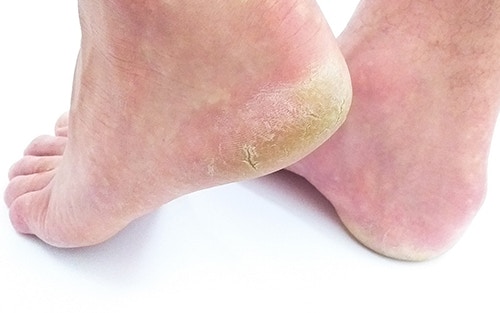
Athlete’s foot or tinea pedis is a skin and foot infection that can be caused by a variety of different fungi. Although tinea pedis can affect any portion of the foot, the infection most often affects the space between the toes.
Causes – Tinea pedis spreads through contact with infected skin scales or contact with fungi in damp areas like showers, locker rooms, swimming pools, etc. Tinea pedis can be a chronic infection that recurs frequently.
Symptoms – Athlete’s foot is typically identified by skin fissures or scales that can be red and itchy.
Treatment – Treatment may include topical creams and powders applied to the skin surface or oral medications.
Recovery Time – It can take 6 months or more to see improvements in conditions, and depending on your diligence in control measures, it may take one year or more to fully eradicate this condition from your home and clothing.
Prevention – dermatologists recommend that you take the following precautions to prevent contracting athlete’s foot:
- Wear shower shoes, flip-flops, or sandals when walking around pools, gyms, shower or locker areas, and hotel rooms
- Even if you have not gone barefoot in public areas, keep your feet dry
- Wash your feet every day with soap and completely dry them afterward
- Wear socks made of fabrics that dry quickly or wick moisture away from the skin, and be sure to change your socks every day
- Alternate the shoes you wear daily, if possible, to make sure shoes are dry when they are put on
- If you live with someone who has athlete’s foot, don’t share towels, linens, socks, or shoes
- Wear shoes when in areas where infected feet have been
- If your athlete’s foot is not improving or is worsening, see a board-certified dermatologist
Read more about athlete’s foot.
Heel Spurs
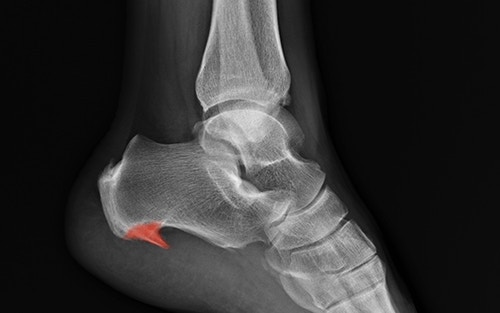
Also known as calcaneal spurs or osteophytes, a heel spur is a bony outgrowth calcium deposit that usually occurs on the underside of a person’s foot.
Causes – Heel spurs occur when calcium deposits build up on the underside of the heel bone. This process usually occurs over many months. Heel spurs are often caused by strains on foot muscles and ligaments, continuous stretching of the plantar fascia, and repeated tearing or injuring of the membrane that envelopes the heel bone.
Symptoms – Heel spurs often cause no symptoms. However, heel spurs can cause intermittent or chronic pain while walking, jogging, or running. The cause of the pain is not the heel spur but the soft tissue injured from it.
Some describe heel spurs and associated plantar fasciitis as a knife or pin jabbing into the bottom of their feet when first standing up in the morning that fades into a dull ache. That sharp pain usually returns after standing up after sitting for a prolonged time.
Treatment – Heel spurs are treated by measures intended to decrease the associated inflammation while avoiding reinjury.
- Local ice applications both reduce pain and inflammation
- Anti-inflammatory medications, such as naproxen (Aleve) and ibuprofen (Advil), or injections of cortisone, are often helpful
- Orthotic devices or shoe inserts can take pressure off plantar spurs (donut-shaped insert)
- Heel lifts can reduce stress on the Achilles tendon to relieve painful bone spurs at the back of the heel
Tip: Sports or running shoes with soft, cushioned soles can be helpful in reducing irritation and discomfort of inflamed tissues from heel spurs.
Surgery may be performed on chronically inflamed spurs as a last resort.
Recovery Time – Healing can take a few weeks to several months, depending on the severity of the spur and how it is treated.
Note: Overweight patients or those who procrastinate seeing a doctor for a diagnosis are likely to suffer longer and are highly likely to have the pain come back.
Prevention – prevent heel spurs by wearing well-fitting shoes with rigid shanks and supportive heel counters. Warming up and stretching your feet before physical activity.
Claw Toe
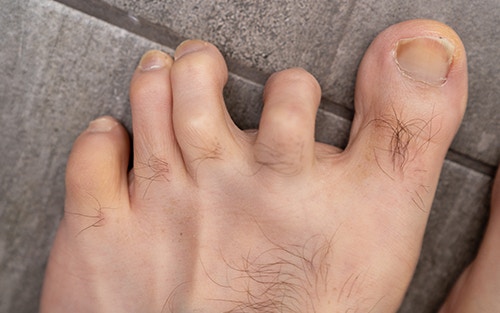
Claw toes, as the name implies, are toes bent into an abnormal claw-like shape. This condition is also called mallet or hammertoe. The condition usually occurs in the four smaller toes of your foot in the middle and end joints.
Causes – Most of the time, an imbalance of foot muscles causes claw toes. Specifically, toe muscles will contract too far, tighten the tendons, and bend the joints. Foot muscles can become unbalanced due to the following:
- Genetics
- Poorly-fitting shoes
- Polio
- Cerebral palsy
- Diabetic nerve damage
- Rheumatoid arthritis
- Osteoarthritis
- Nerve damage caused by alcoholism
- Charcot-Marie-Tooth Disease
- Spinal cord tumors
- Stroke (the stroke-side foot is affected)
- Physical trauma
Symptoms – Claw toe symptoms occur beyond the toes and can include:
- Pain
- Swelling
- Corns
- Calluses
- Blisters
Note: Ulcers are a rare symptom, but they do occur.
Treatment – There are both nonsurgical and surgical treatments for claw toes. Most of them you can do at home. Nonsurgical treatments for claw toes include:
- Wear pads, arch supports, or other shoe inserts to cushion the toe
- Wear shoes with larger toe boxes, low heels, and good arch support
- Wear shoes with increased width and depth, with soft soles and minimal seams in the toebox
- Strengthen and stretch toe muscles through focused exercises
- Use a splint or tape to hold your toes where they should sit
- Avoid high heels
- Avoid tight shoes
The severity of your claw toes will determine what type of surgery you’ll require. Your healthcare provider will categorize your claw toe as early or late stage, either flexible or rigid. Surgical treatments for claw toes include:
- Temporarily inserting a steel pin to hold the toe in the correct position until healing occurs
- Tendon lengthening and/or rerouting
- Shortening the bones of the phalanx
- Toe fusion
Recovery Time – For surgical treatments, you’ll need a minimum of 12 to 18 weeks of recovery time.
Prevention – Wear shoes that do not constrict your toes. Use exercises like extending, then curling the toes, splaying the toes, and moving the toes individually may help prevent the digital contracture that causes claw toe. Such exercises work to keep foot muscles strong and pliable.
Bunions
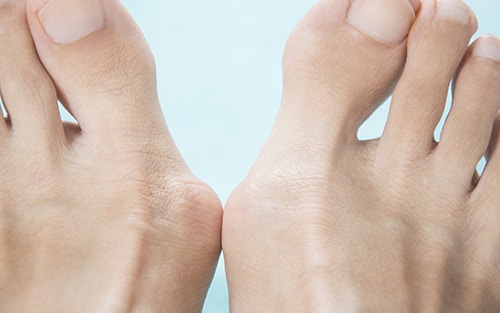
A bunion (hallux valgus) is a bony bump that forms on the joint at the base of the big toe.
Causes – Foot pressure caused by the way you walk or the shape of your foot causes your big toe to abnormally bend in toward the second toe. Bunions are gradually occurring.
Standing for long periods and wearing poorly-fitting, narrow shoes can exacerbate bunion pain but do not cause the problem.
Symptoms – A bunion will cause your big toe to bend inward, turn red and become swollen. Other symptoms include:
- Claw toes (see above)
- Numbness in the big toe
- Trouble bending the big toe, or pain and burning when trying to bend it
- Difficulty wearing regular or narrow shoes
- Corns or calluses (thickened skin)
Tip: Many times, foot problems or disorders are actually symptoms of larger, more complicated conditions.
Treatment – Bunions don’t just go away. Treatment likely will focus on relieving symptoms and may include the following:
- Orthotic devices: Over-the-counter or custom-made shoe inserts can help control toe alignment issues that may be contributing to bunion formation. You can also place a spacer between the big and second toe. Some people find relief by wearing a splint overnight to keep the big toe straight.
- Footwear changes: Switching to shoes with wide, deep toe boxes can take pressure off of your toes.
- Bunion pads and taping: Store-bought bunion pads can cushion the affected area and ease the pain. You can also use medical tape to keep the foot in the correct position.
- Pain relievers: Nonsteroidal anti-inflammatory drugs (NSAIDs) can be combined with ice packs to help manage pain and swelling.
- Therapy: Massage, physical therapy, and ultrasound therapy can break up soft-tissue adhesions, reducing pain and inflammation. There are exercises that can help improve muscle strength around the bunion and can improve alignment.
- Injections: Steroid injections can reduce pain and swelling but may also cause damage if used too often or injected into the joint itself. This is typically a later stage bunion treatment when trying to avoid surgery.
- Surgery: When nonsurgical treatments show little to no improvement and walking becomes extremely painful, your primary care physician/provider may recommend surgery. This surgery is referred to as a bunionectomy and removes the bunion while realigning bones to bring the big toe back into the correct position.
Recovery Time – For surgical treatments, you’ll need a minimum of 12 to 18 weeks of recovery time.
Prevention – The following can help you prevent painful bunions:
- Note the shape of your feet as they age, especially if bunions run in your family
- Exercise the feet to strengthen them
- Only wear shoes that fit properly and avoid cramping or pinching your toes
- Avoid shoes with high heels or pointed toes
Tip: Treat your feet to frequent spa days. Regular foot massages can help you detect and take early measures to avoid more serious conditions from developing.
Foot Problems
In this article, you discovered 7 of the most common and significant foot problems, their causes, how to treat them, and what you can do to prevent them.
Knowing what to do when foot problems occur can save you from developing more severe conditions that can last for years and cause significant pain.
Ignoring foot conditions and not taking action can leave you debilitated, and often requiring avoidable surgeries and extended periods of recovery time.
Sources:
mayoclinic.org/diseases-conditions/plantar-fasciitis/diagnosis-treatment/drc-20354851
my.clevelandclinic.org/health/diseases/15890-metatarsalgia
orthoinfo.aaos.org/en/diseases–conditions/plantar-fasciitis-and-bone-spurs
cdc.gov/healthywater/hygiene/disease/athletes_foot.html
health.harvard.edu/diseases-and-conditions/what-to-do-about-bunions
ipfh.org/foot-conditions/foot-conditions-a-z/metatarsalgia/prevention-and-treatment-of-metatarsalgia
(706) 521-5290
(678) 963-5958